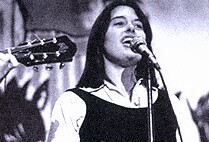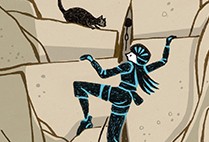Fiction
Girls Who Travel
Nicole Trilivas (COM’05)
Penguin Random House
 Trilivas’ debut offers a refreshing fictional take on a topic often covered in the pages of travel memoirs. Here it provides a fitting setup for this novel, a welcome addition to the burgeoning so-called new adult genre, one that is as much about wanderlust as it is about plain old growing up.
Trilivas’ debut offers a refreshing fictional take on a topic often covered in the pages of travel memoirs. Here it provides a fitting setup for this novel, a welcome addition to the burgeoning so-called new adult genre, one that is as much about wanderlust as it is about plain old growing up.
Wild-haired, bohemian, 23-year-old Kika Shores is back in the States after a year-long backpacking tour and struggling to adjust to working life. As a receptionist at, of all places, a corporate travel management company, she is fulfilling, she thinks, “the part you had to play when you were in your early twenties and one teensy step away from financial destitution.”
That doesn’t mean she plays the part well.
After trading in her swimsuit, South India’s beaches, and freedom for a “fatally boring winter coat,” New York’s crowded subways, and the 9-to-5 grind, she still daydreams of the year of adventure and romance she shared with Lochlon, a brooding Irish backpacker. After one daydream too many, she’s fired from her job.
But Kika’s jobless woes don’t last too long. An opportune phone call from a family friend lands her a nanny gig in London, and she soon finds herself back overseas and once again closer to the roguish Lochlon. For Kika, who muses, “I only started to get a sense of who I wanted to be when I traveled alone,” the London escapade represents a second chance to figure out her life.
With equal parts humor and poignancy, Trilivas captures what it feels like to be an aimless twentysomething. Kika quickly discovers London might not hold all the answers. In fact, the cast of characters she encounters there—like Mina and Gwen, the girls she’s nannying; Celestynka, a Polish housekeeper with a talent for accounting; and Aston, her handsome and mysterious neighbor who claims to dislike travel—only further confuse her as she figures out the direction she wants to take.
In colorful flashbacks to Kika’s year abroad and quaint depictions of London and its cobbled streets, the author also offers up some satisfying armchair travel. Trilivas knows a thing or two about travel; she’s visited more than 30 countries and every continent except Antarctica, and is a manager at a London-based travel marketing company.
Trilivas’ writing sparkles most in Kika’s cheeky, tell-it-like-it-is observations and in side-splitting depictions of her penchant for getting into compromising scenarios (one scene finds Kika in a sex shop while running errands for a nasty coworker).
And though it is a fun, humorous read, Girls Who Travel also touches on the dueling metaphorical implications of travel itself—travel as escape, travel as discovery—for growing up. Coming-of-age, that tidy, overused phrase, might just be something that never stops.—Mara Sassoon
The Island of Worthy Boys
Connie Hertzberg Mayo (Questrom’93)
She Writes Press
 In this debut novel, Hertzberg Mayo takes readers back to late-19th-century Boston and the gritty streets of the city’s impoverished West End. The story revolves around the deepening friendship between two young boys—orphaned, street-wise Charles Wheeler, and the more reserved Aidan Sullivan. When we first meet them, both boys are struggling to survive a world of hunger and indifference, with danger and menace lurking everywhere. The setting evokes the grinding poverty of Charles Dickens’ Oliver Twist, David Copperfield, and A Christmas Carol, where workhouses, jails, and life on the street offered the only means of recourse for children without parents.
In this debut novel, Hertzberg Mayo takes readers back to late-19th-century Boston and the gritty streets of the city’s impoverished West End. The story revolves around the deepening friendship between two young boys—orphaned, street-wise Charles Wheeler, and the more reserved Aidan Sullivan. When we first meet them, both boys are struggling to survive a world of hunger and indifference, with danger and menace lurking everywhere. The setting evokes the grinding poverty of Charles Dickens’ Oliver Twist, David Copperfield, and A Christmas Carol, where workhouses, jails, and life on the street offered the only means of recourse for children without parents.
The boys’ friendship, which develops tentatively and warily, takes on an urgency after an attempted robbery goes disastrously awry. Salvation appears in the form of a kind-hearted prostitute who offers to help Charles and Aidan (who agree to pose as brothers) escape Boston to a farm school on Thompson Island in Boston Harbor. The two assume false identities to protect their secret and avert attention from the authorities.
Happily, none of the characters—adults or children—is reduced to stock figures. Hertzberg Mayo portrays the boys who reside at the Boston Farm School and their adult keepers with originality and a keen eye for detail. Readers will find themselves rooting for Charles and Aidan as they begin to flourish and take their first steps toward building a new life for themselves. Every victory, even the smallest, is hard-won, and loss and sadness are a constant presence.
Just as their lives appear finally secure, a chance return to the mainland puts the boys’ happiness in jeopardy. The story builds to a climactic courtroom scene that threatens to rob the two of their friendship and their future. It would be unfair to describe what happens next, but to the author’s credit, she steers clear of a pat ending.
While clearly a historical novel, The Island of Worthy Boys was inspired by a real-life school, the Boston Farm School, which existed from 1833 to 1975, and its real-life superintendent, Charles Bradley, who served in that position from 1888 to 1922.
The author stumbled on the school’s existence while taking a cruise of the Boston Harbor Islands more than 25 years ago. At the time, the boat’s captain mentioned that a “reform school” had once existed on Thompson Island.
What Hertzberg Mayo discovered was that the real school, far from being a reform school, was that “rare good place” governed by a sense of fairness and compassion. Boys were educated and later apprenticed so they could support themselves in a variety of careers. Hertzberg Mayo was put in touch with a man, Dave Haeger, who had attended the school from 1938 to 1943 and who offered invaluable insight into life on the island as a Farm School student.
The Island of Worthy Boys vividly recalls a chapter in American history before the advent of the Progressive Era and the creation of a safety net to protect children. It deftly explores some thorny issues—forgiveness, compassion, resilience, the individual’s responsibility to society. Sadly, it also serves as a reminder, at a time when income disparity continues to grow in this country, that a child’s future is still too often determined by the circumstances of his birth.—John O’Rourke
Nonfiction
Rebel Rebel
Chris O’Leary (COM’94)
Zero Books
 One more sign that we baby boomers are marching swiftly to the grave: Ziggy Stardust and the Thin White Duke are now the subjects of a reference book. Rebel Rebel catalogs every song David Bowie recorded up to January 1976 in all his personae, with details on the recording sessions, personnel, release schedules, chart peaks, and live performances.
One more sign that we baby boomers are marching swiftly to the grave: Ziggy Stardust and the Thin White Duke are now the subjects of a reference book. Rebel Rebel catalogs every song David Bowie recorded up to January 1976 in all his personae, with details on the recording sessions, personnel, release schedules, chart peaks, and live performances.
But it’s O’Leary’s essays on each song that make the book worthwhile for casual Bowie fans who don’t really care who played rhythm guitar on an unreleased 1972 remake of “John, I’m Only Dancing” (O’Leary: “Lou Reed?”).
“It’s still strange to realize his first single predates A Hard Day’s Night,” O’Leary writes in the introduction. “By keeping to the ground and going through Bowie’s records song by song, you can slowly get a sense of the scale of Bowie’s achievement—a body of work that holds up as well as anything from his era.”
Bowie died on January 10, 2016, two days after his 69th birthday and the release of his new album Blackstar.
O’Leary is good on the music, such as the singular novelty “Space Oddity,” which launched Bowie’s success. Recorded in 1969 in advance of the moon landing, it was on and off the charts for years and even sung by an astronaut on the International Space Station in 2013. O’Leary plumbs the harmonies and chord changes that make the song work, the important role of a goofy little synthesizer called the Stylophone, and the song’s connections to “In the Year 2525,” 2001: A Space Odyssey, “A Day in the Life,” and “Over the Rainbow.”
“Born mournful, it’s become more so,” O’Leary writes of the song. “Bowie had felt something linked the Apollo astronauts (who thought they’d be the opening act of a new age of space exploration and turned out to be one-hit wonders), the doomed astronauts of science fiction, all of the lost boys of the imploding counterculture.” The disappointing arc of his own career to that point and a bad breakup were also on Bowie’s mind.
The author takes us song by song through the extraordinary five years of productivity that followed: “The Man Who Sold the World,” “Changes,” “Life on Mars?,” “Ziggy Stardust,” “Starman,” “All the Young Dudes,” “The Jean Genie,” “Diamond Dogs,” “Young Americans,” “Fame,” and many more, as well as countless album tracks and covers.
Along the way, O’Leary also delves into the cocaine-fueled chameleon act that helped sear Bowie into the popular consciousness, from his alien starring role in The Man Who Fell To Earth to his largely false coming out.
“From 1973 to 1977, Bowie ran an inadvertent guerilla war against television, particularly American television,” O’Leary writes. “If anything, he was gracious, polite, happy to flatter the host. But his emaciated coke-wraith appearance was disturbing merely as a visual,” he writes, and Bowie came across as “estranged, distracted, standing at a remove from humanity. He seemed like an extraterrestrial summoned by the cameras.”
O’Leary promises a second volume covering Bowie from his fertile Berlin period to his final works. A regular biography will be a better starting point for Bowie neophytes. But Rebel Rebel is worthwhile for those who have already learned to turn and face the strange changes.—Joel Brown














































 In this debut novel,
In this debut novel,  One more sign that we baby boomers are marching swiftly to the grave: Ziggy Stardust and the Thin White Duke are now the subjects of a reference book. Rebel Rebel catalogs every song David Bowie recorded up to January 1976 in all his personae, with details on the recording sessions, personnel, release schedules, chart peaks, and live performances.
One more sign that we baby boomers are marching swiftly to the grave: Ziggy Stardust and the Thin White Duke are now the subjects of a reference book. Rebel Rebel catalogs every song David Bowie recorded up to January 1976 in all his personae, with details on the recording sessions, personnel, release schedules, chart peaks, and live performances.


nice